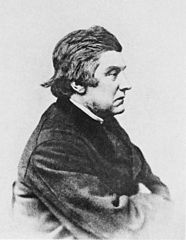Topics > People in History > Albany Hancock (1806 - 1873)
Albany Hancock (1806 - 1873)
Albany Hancock (24 December 1806 – 1873), English naturalist, biologist and supporter of Charles Darwin, was born on Christmas Eve in Newcastle upon Tyne. He is best known for his works on marine animals and coal-measure fossils.
Albany Hancock was brother to the naturalist John Hancock. The brothers lived with their sister, Mary Jane, at 4 St. Mary’s Terrace, Newcastle, now part of a listed terrace at 14-20 Great North Road.
Early life and education
He was educated at The Royal Grammar School, before being articled to a local solicitor. He completed the expected period in articles and passed all the required examinations to become a solicitor himself, even going so far as to acquire an office in Newcastle with a view to establishing his own practice.
Career
His true interests lay elsewhere, and after a brief period of employment with a manufacturing firm, dedicated the rest of his life to his true calling, natural history.
Publications
Although he was an enthusiastic amateur naturalist from childhood, his first serious publications did not appear until 1836, when he was 30. These were Note on the Occurrence of Ranicefis trifurcatus on the Northumberland Coast and Note on Falco ruazlies, Regulus ignicafiillus and Larus in Jardine's Magazine of Zoology and Botany.
From this slow start, Hancock went on to become one of the foremost naturalists of his day, producing some seventy notable publications many in the Annals and Magazine of Natural History.
Hancock was a founder member of the Natural History Society of Northumberland, Durham, and Newcastle upon Tyne, and of the Tyneside Naturalists' Field Club. He was a member of the provisional board that established the College of Physical Science in Newcastle, a Fellow of the Linnean Society, a corresponding-member of the Zoological Society of London and an honorary member of the Imperial Botanico-Zoological Society of Vienna. He was awarded the Royal Medal of the Royal Society in 1858.
Hancock Museum
The Hancock Museum in Newcastle upon Tyne is named after the Hancock brothers, both of whom took an instrumental part in getting the museum built. The museum contains many specimens from their collections.
Visit the page: Albany Hancock for references and further details. You can contribute to this article on Wikipedia.

from https://commons.wikimedia.org…
Albany Hancock (1806-1873)
- Public Domain image c/o Wikipedia. From The British Tunicata. Volume 2 (1907) by Sir Joseph Wilson Swan (1828 - 1914).
Added by
Simon Cotterill

from https://commons.wikimedia.org…
Alder and Hancock British Nudibranchiata Plate 5
- Alder and Hancock British Nudibranchiata Plate 5 (1848)
Added by
Simon Cotterill

Co-Curate Page
Joshua Alder (1792 - 1867)
- Overview About Joshua Alder Joshua Alder (1792 - 1867) was a zoologist and a malacologist, who specialized in the Tunicata, and in gastropods. The Alders were an old Alnwick family, …

Co-Curate Page
John Hancock (1808-1890)
- Overview About John Hancock John Hancock was born in Newcastle on the 24th of February 1808. As well as being a naturalist, ornithologist, and landscape architect he is considered to be …


from https://commons.wikimedia.org…
Albany Hancock (1806-1873)
- Public Domain image c/o Wikipedia. From The British Tunicata. Volume 2 (1907) by Sir Joseph Wilson Swan (1828 - 1914).
Added by
Simon Cotterill

from https://commons.wikimedia.org…
Alder and Hancock British Nudibranchiata Plate 5
- Alder and Hancock British Nudibranchiata Plate 5 (1848)
Added by
Simon Cotterill

Co-Curate Page
Joshua Alder (1792 - 1867)
- Overview About Joshua Alder Joshua Alder (1792 - 1867) was a zoologist and a malacologist, who specialized in the Tunicata, and in gastropods. The Alders were an old Alnwick family, …









